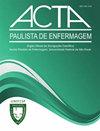肝移植后疫苗认知度低:分析与教育策略
IF 1
4区 医学
Q3 NURSING
引用次数: 0
摘要
目的:评价患者和卫生保健专业人员在实施教育意识策略前后对肝移植后疫苗接种方案的了解情况。方法:患者(n=124)通过访问包含教育视频的网页进行教育干预,卫生专业人员(n=111)通过研讨会和访问项目虚拟页面上的信息进行教育干预。为了分析干预的效果,在干预前后分别使用问卷对知识进行定性分析。结果:患者中男性居多(66.9%),平均年龄55.2岁(SD + 15.9)。82.2%的患者前往UBS接种疫苗,其中13.7%的患者前往cry(特殊免疫生物制剂参考中心)。仅46.7%的患者接受了肝移植后疫苗的相关指导。从卫生专业人员回答的111份问卷中,46.5%的人没有检查疫苗组合,61.3%的人将患者转介到UBS, 38.7%的人转介到CRIE。在干预后分析中,66.1%的患者观看了有关疫苗接种的教育视频。其中,62.2%的人表示他们对疫苗的了解有所提高,91.4%的人认为接种疫苗更安全。教育干预后,45名卫生专业人员回答了问卷。30.4%的人表示知道该开哪种疫苗,67.4%的人向患者亲属推荐疫苗。结论:本研究提出的教育策略可以提高人们对肝移植后免疫方案的认识。这可能有助于避免卫生保健专业人员缺乏信息和未能解决疫苗接种问题的潜在风险。本文章由计算机程序翻译,如有差异,请以英文原文为准。
Low post-liver transplant vaccine awareness: analysis and educational strategy
Objective: To evaluate patients’ and healthcare professionals’ knowledge about vaccination protocols in post-liver transplantation before and after applying an educational awareness strategy in this population.
Methods: Patients (n=124) underwent the educational intervention through access to a webpage containing educational videos and, for health professionals (n=111), through a symposium and access to information on the project’s virtual page. To analyze the effect of the intervention, qualitative analyses of knowledge were carried out using questionnaires before and after the interventions.
Results: Among patients, males were predominant (66.9%) and the mean age was 55.2 years old (SD + 15.9). 82.2% of patients visited a UBS to be vaccinated and 13.7% of them the CRIEs (Reference Center for Special Immunobiologicals). Only 46.7% received orientation about vaccines after liver transplantation. From the 111 questionnaires answered by health professionals, 46.5% did not check the vaccine portfolio, 61.3% referred patients to UBS and 38.7% to a CRIE. In the post-intervention analysis, 66.1% of patients watched educational videos about vaccination. Of these, 62.2% said they had improved their understanding about vaccines and 91.4% feel safer to vaccinate. After the educational intervention, 45 health professionals answered the questionnaire. 30.4% said they knew which vaccines to prescribe, and 67.4% recommended vaccines to patients’ relatives.
Conclusion: The proposed educational strategy applied in this study shown to increase awareness regarding the post-liver transplant immunization protocols. This may contribute to avoiding the potential risk of lack of information and failure to address vaccination by healthcare professionals.
求助全文
通过发布文献求助,成功后即可免费获取论文全文。
去求助
来源期刊

Acta Paulista De Enfermagem
NURSING-
CiteScore
1.40
自引率
0.00%
发文量
92
审稿时长
4 weeks
期刊介绍:
Acta Paulista de Enfermagem – (Acta Paul Enferm.), ISSN 1982-0194, is a [bilingual] technical-scientific electronic publication of the Escola Paulista de Enfermagem – EPE, Universidade Federal de São Paulo – UNIFESP.
Our mission: To disseminate the scientific knowledge generated within the rigor of research and ethics methodology.
Our objective: To publish results of original research for advancement of practices of clinical, surgical, and management nursing, as well as education, research, and information and communication technology.
 求助内容:
求助内容: 应助结果提醒方式:
应助结果提醒方式:


